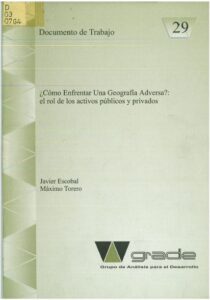¿Cómo enfrentar una geografía adversa?: el rol de los activos públicos y privados
| Year | : | 2000 |
|---|---|---|
| Author/s | : | Javier Escobal, Maximo Torero |
| Area/s | : | Poverty and equality, Natural resources, extractive industries and social conflict |
Escobal, J. y Torero, M. (2000). ¿Cómo enfrentar una geografía adversa?: el rol de los activos públicos y privados (Documento de trabajo N° 29). Lima: GRADE.
In Peru, a country with an astonishing ecological diversity, with 84 different climatic zones and landscapes, with tropical rainforests, high mountain ranges and deserts, the geographical context may not be sufficient to explain regional variations in income and welfare, but it is very significant. The most important question this paper seeks to answer is: what role do geographic variables – both natural and anthropogenic – play in explaining differences in per capita expenditure across regions in Peru. How have these influences changed over time, through what means have they been transmitted, and whether access to private and public assets has offset the effects of adverse geography.
We have shown that apparent geographic differences in living standards in Peru can be almost entirely explained when the spatial concentration of households with easily observable non-geographic characteristics, particularly public and private assets, is taken into account. In other words, an adequate endowment of public and private assets overcomes the potentially negative effects of adverse geography.
However, this does not mean that geography is not important, but rather that its influence on the level of spending and differences in growth arises from the uneven arrangement of public infrastructure across space. Moreover, when we measure the expected gain (or loss) in consumption from living in one geographic region (the coast) as opposed to living in another (the highlands) we find that much of the difference in the logarithm of per capita expenditure between the highlands and the coast can be explained by differences in infrastructure resources and private assets. This could indicate that the availability of infrastructure would be limited by geography, so that the most adverse geographic regions have the least access to public infrastructure.
Importantly, there appear to be omissions of non-geographic, spatially correlated variables that need to be accounted for in our spending growth model. Therefore, public policy programs that take into account differences in access to private and public assets and target certain regions may make sense, even if geographic variables do not explain much of the difference in regional growth.







